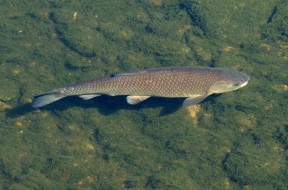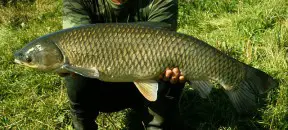Ctenopharyngodon idella
Grass Carp
SynonymsTop ↑
Leuciscus idella Valenciennes, 1844; Leuciscus tschiliensis Basilewsky, 1855; Ctenopharyngodon laticeps Steindachner, 1866; Sarcocheilichthys teretiusculus Kner, 1867; Pristiodon siemionovii Dybowski, 1877
Etymology
Ctenopharyngodon: from the Ancient Greek κτείς (kteís), meaning ‘comb’, φάρυξ (pháruks), meaning ‘throat’, and ὀδών (odṓn), meaning ‘toothed’, in reference to the comb-like pharyngeal teeth in this genus.
idella: probably from the Ancient Greek ἴδιος (ídios), meaning ‘distinct’, in relation to its unique characters which set it apart from all other cyprinids.
Classification
Order: Cypriniformes Family: Cyprinidae
Distribution
This species is native to the Amur River system in eastern Russia and northeastern China plus other Pacific drainages in China with the Xi River representing its southern limit.
It has been widely introduced on a global scale for aquaculture and as a biological controller of aquatic vegetation in numerous territories, in many of which it is has caused considerable damage to natural environments, although reproductive populations may have become established only in the northern United States.
Confirmed records of stocking exist from Afghanistan, Algeria, Argentina, Albania, Algeria, Armenia, Azerbaijan, Bangladesh, Belarus, Belgium, Bhutan, Bolivia, Brazil, Brunei Darsm, Cambodia, Canada, Colombia, Cote d’ Ivoire, Croatia, Cuba, Cyprus, Czech Republic, Denmark, Egypt, Ethiopia, Fiji, Finland, Guyana, Hawaii, Honduras, Hong Kong, Hungary, India, Indonesia, Iraq, Islamic Republic of Iran, Israel, Italy, Jamaica, Japan, Kazakhstan, Kenya, Democratic People’s Republic of Korea, Kyrgyzstan, Laos, Latvia, Malaysia, Mauritius, Mexico, Republic of Moldova, Mongolia, Morocco, Mozambique, Myanmar, Nepal, Netherlands, New Zealand, Nigeria, Pakistan, Panama, Peru, Philippines, Puerto Rico, La Réunion, Romania, Rwanda, Serbia and Montenegro, Singapore, Slovakia, Slovenia, South Africa, Sri Lanka, Sudan, Sweden, Taiwan, Tanzania, Thailand, Tunisia, Turkey, Turkmenistan, United Kingdom, Ukraine, United Arab Emirates, Uruguay, United States, Uzbekitsan, and Vietnam.
Type locality is given simply as ‘China’.
Habitat
Displays a preference for lowland, slower-moving sections of large rivers, plus lakes and reservoirs with abundant vegetation and relatively shallow water. It is extremely tolerant of deteriorating water conditions and has been recorded in numerous natural and artificial habitat types, however.
Maximum Standard Length
Typical adult size is 800 – 1200 mm with a weight of 20-30+ kg.
Aquarium SizeTop ↑
Suitable only for outdoor ponds, public installations or the very largest, highly-specialised private aquaria.
Maintenance
A large, mature filter system, rigorous maintenance regime comprising weekly water changes of 50-70% tank volume should be considered mandatory, otherwise no special requirements.
Any aquatic plants are likely to be consumed very quickly.
Water Conditions
Temperature: 0 – 33 °C
pH: 6.0 – 9.0
Hardness: 36 – 447 ppm
Diet
Primarily herbivorous, it should be offered cultivated duckweed and fresh fruit and vegetables, and adults will require considerable quantities of these. Wild specimens are also known to feed on organic detritus, aquatic insects and other invertebrates, but larger prey are avoided.
Behaviour and CompatibilityTop ↑
Generally peaceful and will not predate on anything more than a few centimetres in length.
Sexual Dimorphism
Adult, gravid females are noticeably deeper-bodied than comparatively-aged males.
Reproduction
This species is produced on an intensive basis in aquaculture projects across the planet, although many of these efforts are aided by the artificial use of hormones since this species often requires a number of years, sometimes more than a decade, to become sexually mature. It is highly fecund with each female capable of depositing over a million eggs during the reproductive season.
NotesTop ↑
Despite being a wholly unsuitable aquarium subject, C. idella is often traded as such, with an albino form having been developed specifically for the ornamental market. Individuals which have outgrown their aquarium or pond should never be released into natural waters, either, since this species has proven capable of causing serious environmental damage under a wide range of climatic conditions.
For example, it has been observed to completely eliminate or feed selectively on soft-leaved aquatic plants, altering trophic structure or enhancing development of tougher plants. Such removal of macrophyte cover, eliminates spawning substrate, disturbs sediment, increases turbidity, reduces water quality, increases nutrients, promotes algal blooms, decreases dissolved oxygen, and thus accelerates eutrophication. It competes with native species for food and other resources, and can also carry contagious diseases and parasites such as Asian tapeworm, Bothriocephalus opsarichthydis.
The genus Ctenopharyngodon is monotypic and its precise taxonomic placement within the family Cyprinidae is still unclear, although it is certainly not closely related to carp of the genus Cyprio. It has been placed in various subfamilies including Cyprininae, Leuciscinae, and Xenocyprinidae, while recent authors have tended to group it in the subfamily Squaliobarbinae alongside the genera Squaliobarbus and Mylopharyngodon. Molecular studies have suggested it might form a lineage with Hypophthalmichthys, Ochetonius and possibly Luciobarbus and Elopichthys, but this is contradicted by morphological evidence.
Externally, C. idella appears most similar to Mylopharyngodon piceus, which is also native to China but has been widely introduced elsewhere. It can be identified by the following combination of characters, however: body colour olive to brassy green dorsally, silvery white ventrally; cylindrical body shape; pharyngeal teeth serrated and compressed laterally, with a groove on the grinding surface, and usually arranged in two rows.
References
- Cuvier, G. and A. Valenciennes, 1844 - Tome dix-septième. Suite du livre dix-huitième. Cyprinoïdes. v. 17: i-xxiii + 1-497 + 2 pp.
Histoire naturelle des poissons. - Cunha, C., N. Mesquita, T. E. Dowling, A. Gilles, and M. M. Coelho, 2002 - Journal of Fish Biology 61(4): 929-944
Phylogenetic relationships of Eurasian and American cyprinids using cytochrome b sequences. - Kottelat, M., 2013 - The Raffles Bulletin of Zoology Supplement 27: 1-663
The fishes of the inland waters of southeast Asia: a catalogue and core bibiography of the fishes known to occur in freshwaters, mangroves and estuaries. - Kottelat, M. and J. Freyhof , 2007 - Kottelat, Cornol, Switzerland and Freyhof, Berlin, Germany. Publications Kottelat: xiii+ 1-646
Handbook of European freshwater fishes. - Page, L. M. and B. M. Burr, 2011 - Houghton Mifflin Harcourt: 1-688
Peterson Field Guide to Freshwater Fishes of North America North of Mexico (Second Edition).









